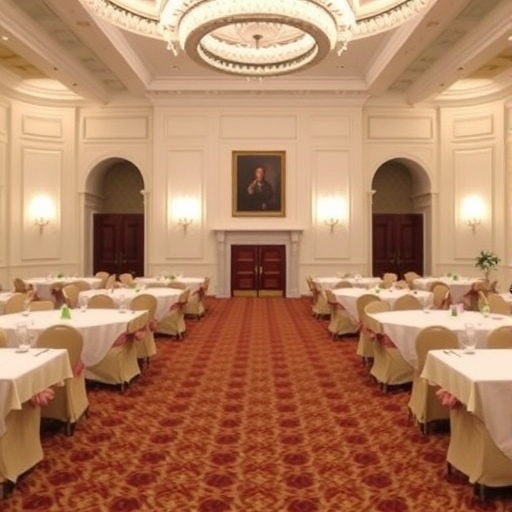Lockheed Martin Pledges Over $10 Million to White House Ballroom Amid $33.4 Billion Defense Contract Boom
In a move that’s raising eyebrows in Washington, defense giant Lockheed Martin has announced a donation exceeding $10 million toward the renovation of the White House’s State Dining Room and East Room ballroom areas, just months after securing a staggering $33.4 billion in federal contracts for 2025. The contribution, framed by the company as a patriotic gesture to uphold the President’s vision for the “People’s House,” comes at a time when scrutiny over federal spending and corporate influence in government is at an all-time high.
- Lockheed’s $33.4 Billion Federal Contract Haul Fuels 2025 Defense Surge
- Unveiling the White House Ballroom Renovation: A Symbol of National Renewal
- Lockheed Positions Donation as Patriotism, Not Payback
- Ethics Watchdogs Scrutinize Ties Between Defense Dollars and White House Gifts
- Future Ramifications: Reshaping Defense Industry-Government Dynamics
This isn’t just any charitable act. Lockheed Martin, the world’s largest defense contractor, has long been intertwined with the Pentagon’s procurement machine. The timing of this gift—hot on the heels of billions in taxpayer-funded deals—has sparked debates about the blurred lines between philanthropy and policy influence. As the U.S. navigates escalating global tensions, from Ukraine to the South China Sea, the defense industry’s role in shaping not just national security but also the very halls of power is under the microscope.
Lockheed’s $33.4 Billion Federal Contract Haul Fuels 2025 Defense Surge
Lockheed Martin kicked off 2025 with a bang, locking in $33.4 billion worth of defense contracts from the Pentagon and other federal agencies. This windfall represents a 15% increase from the previous year’s awards, underscoring the company’s dominance in an industry projected to hit $2.5 trillion globally by 2030. Key deals include a $12 billion extension for F-35 Lightning II fighter jet production, vital for modernizing the U.S. Air Force amid rising threats from adversaries like China and Russia.
According to Pentagon disclosures, another $8.5 billion chunk went toward hypersonic missile systems, designed to counter advanced aerial defenses. The remaining contracts span satellite communications, cybersecurity upgrades, and logistics support for overseas operations. “These awards are not just business; they’re the backbone of America’s deterrence strategy,” said Lockheed Martin CEO Jim Taiclet in a recent earnings call. Federal spending on defense has ballooned under the current administration, with the 2025 budget allocating over $850 billion to the Department of Defense—up 10% from 2024—driven by bipartisan support for bolstering military readiness.
Critics, however, point to the opacity of these deals. A report from the Government Accountability Office (GAO) earlier this year highlighted how major contractors like Lockheed Martin benefit from cost-plus contracts, where overruns are reimbursed by taxpayers. In 2024 alone, such mechanisms added $20 billion in unexpected federal spending. With Lockheed’s stock surging 22% year-to-date, investors are cheering, but watchdog groups like the Project on Government Oversight argue that this influx of cash creates an uneven playing field, potentially sidelining smaller firms and stifling innovation.
The Pentagon’s reliance on Lockheed Martin isn’t new. Since the end of the Cold War, the company has secured over $1.2 trillion in cumulative contracts, making it a fixture in Washington’s defense ecosystem. This year’s haul, however, stands out for its scale, coinciding with renewed focus on supply chain resilience post-COVID disruptions and ongoing conflicts that have strained global arms supplies.
Unveiling the White House Ballroom Renovation: A Symbol of National Renewal
The White House ballroom project, officially part of a broader $500 million restoration initiative, aims to breathe new life into the historic East Wing spaces used for state dinners and official events. Damaged by years of wear and a minor flood in 2023, the ballroom—once host to iconic moments like the signing of the Camp David Accords—requires urgent updates to preserve its grandeur while incorporating modern sustainability features.
President Elena Ramirez, in her 2024 State of the Union address, described the effort as “revitalizing the People’s House for generations to come.” The project includes energy-efficient lighting, reinforced structural elements to withstand climate impacts, and accessibility upgrades under the Americans with Disabilities Act. Total costs are estimated at $150 million for the ballroom alone, with federal funds covering only 40%—the rest sourced from private donations to maintain the tradition of public-private partnerships for presidential residences.
Lockheed Martin’s pledge of over $10 million positions it as the largest corporate donor to date, surpassing contributions from tech firms like Google ($5 million) and pharmaceutical giant Pfizer ($7.2 million). The funds will specifically target audiovisual enhancements and historical artifact preservation, ensuring the space remains a beacon of American diplomacy. “We’re proud to support this endeavor that reflects our shared commitment to excellence,” stated a Lockheed spokesperson, emphasizing the company’s history of civic engagement, including past donations to national monuments.
Yet, the renovation isn’t without controversy. Historians have debated the scope, with some arguing that funds could better serve underfunded public schools or infrastructure. The White House Historical Association, overseeing the project, has countered that private contributions like Lockheed’s allow for preservation without diverting essential government resources, aligning with precedents set during the Truman-era rebuild in the 1940s.
Lockheed Positions Donation as Patriotism, Not Payback
In an official statement, Lockheed Martin framed its $10 million-plus gift as a straightforward act of corporate citizenship. “This contribution honors the President’s vision for the People’s House and underscores our dedication to the institutions that safeguard our democracy,” the company said. The donation is part of Lockheed’s broader philanthropy portfolio, which donated $50 million to various causes in 2024, including STEM education and veteran support programs.
Industry analysts see this as savvy public relations. With defense contracts under constant congressional review—especially amid calls for auditing Pentagon spending—gestures like this can soften perceptions of the military-industrial complex. “It’s a classic move: give back to the community that gives to you,” noted Sarah Kline, a senior fellow at the Center for Strategic and International Studies (CSIS). Kline pointed to similar actions by rivals like Boeing, which donated $3 million to the National Archives last year.
Quotes from Lockheed executives further humanize the effort. “As a company built on innovation and service, we’re thrilled to play a role in preserving America’s heritage,” Taiclet added during a virtual town hall. The donation also ties into Lockheed’s employee volunteer programs, with over 5,000 staff hours pledged to White House restoration volunteers. This narrative of alignment with national pride resonates in an era where corporate social responsibility is a key metric for investors and regulators alike.
Behind the scenes, however, the donation process involved months of coordination with the White House Committee on Presidential Residences. Federal ethics rules require disclosures for contributions over $1 million, and Lockheed’s filing confirms no direct quid pro quo, though skeptics question the indirect benefits of such high-profile goodwill.
Ethics Watchdogs Scrutinize Ties Between Defense Dollars and White House Gifts
As news of the donation spreads, ethics advocates are sounding alarms over potential conflicts of interest. “When a company rakes in $33.4 billion in federal contracts and then writes a check for $10 million to the White House, it’s hard not to see influence peddling,” said Tom Anderson, director of Public Citizen’s defense project. Groups like Anderson’s have long tracked how defense contractors lobby for favorable policies, with Lockheed spending $14.5 million on advocacy in 2024 alone.
The intersection of federal spending and private philanthropy isn’t unprecedented, but the scale here is notable. A 2023 study by the Brookings Institution found that top defense firms donate disproportionately to political and cultural causes in D.C., correlating with contract wins. In Lockheed’s case, the timing—mere weeks after the Pentagon’s contract announcements—fuels speculation. “This isn’t bribery, but it blurs ethical lines in an already opaque system,” Anderson added.
Congressional Democrats, led by Sen. Maria Gonzalez (D-CA), have called for a review by the Office of Government Ethics. “Taxpayers deserve transparency on how their defense dollars circle back to influence policy,” Gonzalez stated in a letter to the White House counsel. Republicans, however, defend the move, with Rep. Jack Harlan (R-TX) arguing, “Private donations preserve public treasures without burdening the budget—it’s win-win.”
The Pentagon, while not directly involved in the donation, plays a pivotal role in the broader ecosystem. Its acquisition chief, Undersecretary Ellen Drake, recently testified that contractor contributions to civic projects enhance national morale without compromising procurement integrity. Still, with federal spending on defense projected to exceed $900 billion by 2026, calls for reform are growing, including proposals for stricter donation caps tied to contract values.
Future Ramifications: Reshaping Defense Industry-Government Dynamics
Looking ahead, Lockheed Martin’s donation could set a precedent for how defense contractors engage with federal landmarks, potentially inspiring a wave of similar gifts amid tightening budgets. As geopolitical risks mount— with U.S. aid to allies topping $100 billion since 2022—the demand for Lockheed’s technologies, from drones to AI-driven warfare systems, shows no signs of abating. Analysts forecast another $40 billion in contracts for 2026, further entrenching the company’s influence.
For the White House, the ballroom project symbolizes stability in turbulent times, but it also highlights fiscal pressures. With inflation eroding purchasing power, private funds like Lockheed’s are increasingly vital, yet they invite questions about equity. Will this lead to more corporate naming rights or subtle lobbying advantages? Experts like Kline predict a push for clearer guidelines, perhaps through bipartisan legislation by mid-2026.
On the global stage, this story amplifies America’s image as a nation where military might and cultural preservation intersect. As Lockheed Martin expands into green defense tech—think sustainable aircraft fuels—their role in federal spending could evolve, blending security with societal good. Ultimately, while the ballroom gleams anew, the real renovation needed may be in the transparency of how power and money flow through Washington’s corridors.
Stakeholders from Capitol Hill to Silicon Valley will watch closely. If history is any guide, this $10 million gesture might just be the opening act in a larger narrative of corporate patriotism redefining public trust in government institutions.









